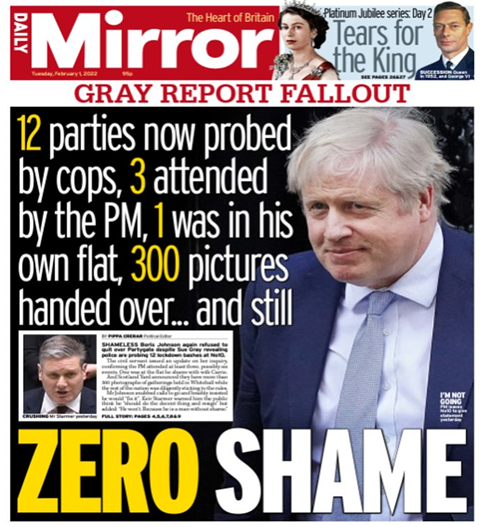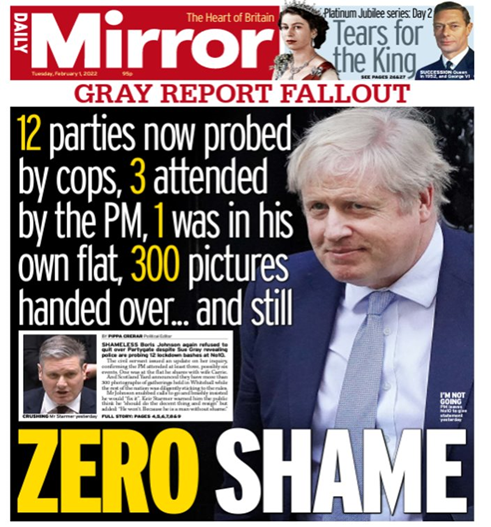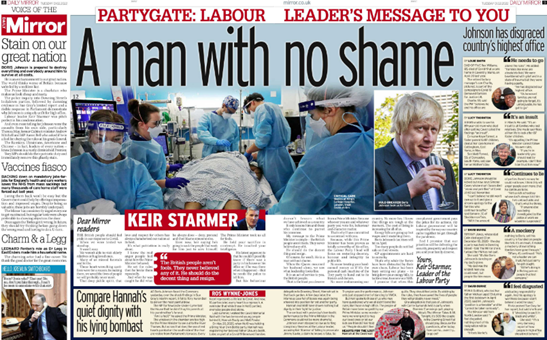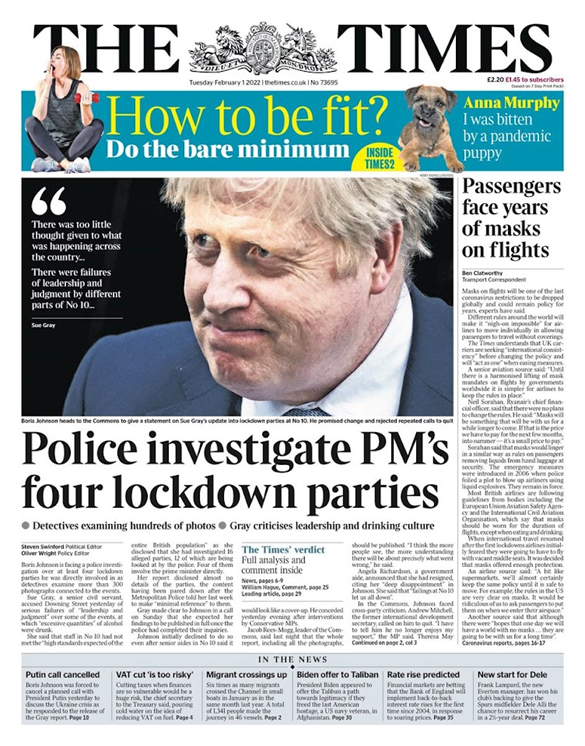Newspapers
1/31
There's no tags or description
Looks like no tags are added yet.
Name | Mastery | Learn | Test | Matching | Spaced |
|---|
No study sessions yet.
32 Terms
What are some conventions of newspapers?
· Masthead
· Mid-shot, close-up of the main subject (Boris Johnson)
· Large pieces of text- the headline of the news
· Quotes from big figures- Boris, Keir Starmer
What are tabloids?
They are newspapers for the average person with a lower income
They are more emotive and biased
The are involved in lowbrow culture such as gossip and celebrity culture
The audience is mainly C2DE
The assumption is that these audiences don’t like to read so they have brighter colours
These newspapers tell the readers what to think
What are quality newspapers?
ABC1- higher income audience, more cultural capital
More of a focus on world events
Is much less biased as it assumes the reader is knowledgeable enough to form their own opinion
Normally muted colours
Highbrow culture- A list celebrities, talking about leaders and public figures
More formal and less emotive
When was the Daily Mirror established and how does it promote itself?
Established in 1903
Predominantly working class readership
Traditional left-wing political stance- has always sided with labour
Slogan- ‘The Heart of Britain’ suggesting that the Newspaper stand up for the common man and is a key part of the social and cultural life in the UK
Critical of conservative government for their handling of the Coronavirus pandemic
When was The Times established and how does it promote itself?
· British National ‘quality newspaper’, first published in 1785
· These newspapers can also be referred to as ‘broadsheets
· A subsidiary of News UK which is wholly owned by News Corp, Rupert Murdoch’s company
· Adopts a central position compared to the tabloid which tell it’s viewers who to support
· It does have a right-wing allegiance however and supports the conservative party and key-times, such as in general elections
· The newspaper describes itself as the following: ‘A faithful recorder of the times for more than 200 years
What is right wing, centrism and left wing?
Right wing: The right wing refers to those with conservative views. They favour tradition, promote private ownership and capitalism, oppose immigration and want to limit change from tradition. Fascism is the most extreme form of right-wing politics.
Centrism: Centrists have moderate views and do not favour the extremes of both sides. They generally do not wholeheartedly support a political party and change who they support based on received information.
Left wing: The left wing refers to those with progressive politics. They tend to be anti-racist, support workers' rights, oppose capitalism and favour social ownership. The most extreme form of left-wing politics is communism.
What side of the political spectrum are the Daily Express, Independent, The Sun, and The Guardian?
Daily Express- Right wing
Independent- Left wing
The Sun- Right Wing
The Guardian Left Wing
Social and Cultural Context
What is the context around the Daily Mirror text?
· This edition of newspaper deals with the scandal surrounding allegations and social gatherings held by the conservative party during lockdown
· The scandal surrounding these allegations commonly became known as ‘Partygate’
· The suffix ‘gate’ was first used in the ‘Watergate’ scandal in the US in the 1970s which resulted in the resignation of President Richard Nixon
· The Daily Mirror largely targets a lower middle class/working class and so, it criticized the government for violating rules that they felt didn’t apply to them
· A common social theme for this newspaper is ‘us VS them’
· This editorial assert itself as the voice of ‘the British people’ saying ‘it makes us look cheap and nasty’

How is text used to create meaning within this newspaper?
Zero shame- Highlighted, biggest text of the page
Informal use of language- cops, identification with a lower-class audience
Yellow to highlight- stands out amongst the rest of the text, complimentary colour to red so probably the first thing you would read
- Distinguished from the red theme of the Daily Mirror
“I’m not going” in the smallest text- the words of Boris Johnson seem unimportant to the Daily Mirror
“The heart of Britain” selling itself as standing with the people and speaks as the general voice, positions readers pick the side of being against Boris Johnson
Yellow- used to highlight stats and represents cowardice and deceit (Barthes)
Red- Anger
“Gray Report Fallout” referring to Sue Gray’s report of lockdown parties- appeal to authority makes outrage more credible

How are camera shots used to position audiences in this newspaper?
Mid shot- shows Boris Johnson smiling, made to seem despicable, also fits the ‘zero shame’ headline
Shows opposition next to Boris in box- Keir Starmer, Binary opposition, Keir- hero
Eye level shot- not put on a pedestal

How does this newspaper create meaning and position audeinces?
Boris smirking- made to look pompous, no remorse
Boris is sipping on a wine glass contrasted with the image of a life or death situation on an operating table
Lighting is used on Boris’ face to make him look sinister to the audience
“A man with no shame”- does not address Boris by name- does not see him as any legitimate authority
“Keir Starmer” in bold text surrounded by a red box- shows much more respect on his name, also the same name as the main colour of the newspaper reflecting political position
Hardworking doctors contrasted with Boris partying- exploitation of NHS workers which they were supposed to protect during the pandemic
Described him as a disgrace and Keir Starmer says “he should do the decent thing and resign”

How is text used in this newspaper to position audiences and create meaning?
Quote from Sue Gray who actually did the investigation- Shows the times aligns itself more with the facts of the situation rather than taking sides, allows educated audience to make their own assumptions
“Detectives examining hundreds of photos” and “Gray criticises leadership and drinking culture” Large and bold but not highlighted, ABC1 audience expected to be more inclined to read, no large headlines to draw attention, once again presenting the facts and asks the audience to form their own opinion
· "Passengers face years of masks on flights” may incline viewers to oppose Bojo, also relates to upper class readers as they would have the money buy this
“The Time’s verdict- full analysis”- source of authority
“Cross-party criticism”
Political stories at the bottom of the page- cultural capital
More advanced lexis- more educated audience
Upper class audiences who may not work full time have more time to go to the gym and “do the bare minimum”
VAT- more wealthy audience as this tax would perceive to have a lesser effect on a lower class audience
How is imagery used to create meaning and position audiences in The Times?
Close up of Boris used- not a photo of his smirking or anything, once again the audience is not influenced by outside factors as whether to trust Bojo or not
Dedicates an entire section to the whole controversy rather than leaving it at an accusation
What is Gramsci’s representation theory of cultural hegemony?
The dominant thoughts of a society which benefits the ruling class
Societal norms is the way through which cultural hegemony is enforced
The domination of a culturally diverse society by a ruling class who manipulate the culture of society for their own benefit
The beliefs, perceptions, values and mores of society are controlled by the ruling class and become the dominant ideology
These beliefs are then constructed to be invisible, natural and beneficial but are truly artificial and only benefit the ruling class
What was the Levenson Inquiry and what is IPSO?
Judicial public inquiry into the culture, practices and ethics of the British press
Public hearings held between 2011-2012
IPSO- Independent Press Standards organisation
- The largest independent regulator for the newspaper and magazine industry
- They hold newspapers and magazines to account for their actions, protect individual rights and uphold high standards of journalism
- Support members of the public in seeking redress where they believe that the Editor’s Code of Practice has been breached
- Both The Times and The Mirror are part of IPSO
How has the digital revolution affected the Times and the Daily Mirror?
The times.co.uk and Sunday-times.co.uk were launched in 1996
· Paywall- A restriction of access to media unless one pays for the service/subscription
· The times online introduced a paywall on 2 July 2010
· They introduced this to increase revenue after years of decline in paid print readership and advertising revenue, partly due to the use of ad blockers
· Visits to the website deceased 87% since the paywall was introduced from 21 million to 2.7 million per month
How has the digital revolution affected newspapers?
· Online media has been largely responsible for the downturn in print sales
· The Mirror online has a large presence online and offers interactive opportunity with its readers
· The News Corp group was one of the first companies in the UK to introduce and online newspaper but also paywalls
What is David Hesmondhalgh’s cultural industries theory?
The ultimate goal of companies/conglomerates is to minimise risk while maximising profit
This can be done through
Digital expansion
Vertical integration
Horizontal integration
A media merger
How does Hesmondhalgh’s cultural industries theory link to newspapers?
In order to stay relevant, media conglomerates have to expand digitally
This is because the use/buying of physical media decreases while the use on online media increases
This reduces risk and maximises profit as physical newspapers are a risk and readers can be unpredictable
What is Reach PLC?
Reach PLC- The biggest commercial news publisher in the UK and Ireland
Own brands such as the Mirror, Express, Daily Record and Daily star as well as many local brands- horizontal integration
Digital expansion- they have a website, no paywall, contact section
How can the use of online media expand the audience?
Physical media appeals more to an older audience that is more used to reading physical as they grew up with it
Younger generations are less inclined to physical media and mostly receive information through online sources like social media
In order to capitalise on this, media industries should expand their reach to online websites and social media platforms to reach a younger audience
This way producers can reduce risk by expanding their reach and maximise their audience which maximises profit
What is The Times’ target audience?
· Age: 30-60
· Upper-middle – Upper Class
· Occupation-White collar jobs in government, consulting, academia
· Male
· Full time workers – People in retirement
· Psychographics- Aspirers and succeeders
What is Gerbner’s cultivation theory?
The more one consumes a particular media text, the more one will start to associate the media with the real world
At some point, a person cannot differentiate between the media they consume and reality
Mean world syndrome: The more a person watches news that is negative, the more negative the world will appear to them
What is Livingstone and Lunt’s regulation theory?
Media serves a range of purpose and must balance a range of citizen and consumer needs
Regulation is needed to ensure the media promotes public interests
We are all citizens and consumers
As citizens, we expect protection from harm and some regulation of the press must meet both expectations
Livingstone and Lunt argue these expectations can be in conflict so it’s difficult to regulate efficiently, especially with digital convergence as the UK doesn’t own the internet
Media companies may work harder to please the consumer than the citizen
How does Livingstone and Lunt link to online media?
Traditional forms of media regulation are being challenged by online globalised media
This is because the internet is international and publication does not require a license
What is Clay Shirky’s End of Audience Theory?
Technological developments have change the relationship between producers and consumers
In the past, media producers created content for audiences but now, audiences can create content, making them more active
Prosumers vary in their motivations to professional producers
This creates cognitive surplus where a large number of people give their time and expertise to create something
Therefore, audiences can no longer be seen as a single mass of people
What is Curran and Seaton’s theory?
Companies are driven by the logic of power and profit
This power centralises in the hands of a few companies
This concentration limits diversity, creativity and quality of media products
What is Stuart Hall’s reception theory?
Readers can interpret the message of a text in three ways:
Preferred reading- The message the producer wanted to convey
Negotiated reading- The audience accepts parts of the message that the producer attempts to convey but rejects others
Oppositional- The audience is in complete opposition to the message of the producer
What is gatekeeping?
· A gatekeeper is who decides what is omitted and included
· People responsible for deciding appropriate stories to appear in newspapers
· They may be owner, editor or senior journalists
What is a prosumer and how does this affect producers?
· When the consumer becomes a producer
· This gives the consumer a sense of ownership of the news while also connecting users
· If producers do not allow for interaction, viewers will go elsewhere and they miss out on profit
What is below the line commentary?
· The concept of audience members as passive consumers is no longer tenable in the age of the internet
· Due to the rise of the prosumer producing their own content
· Newspapers embrace this, taking below the line/non-professional commentators and putting them into above the line columns in online editions
As well as this there are comment sections on some websites for audience interaction
What are News values?
Categories by which we determine events to be newsworthy:
· Conflict
· Impact
· Prominence
· Timeliness
· Interest
· Proximity
· Currency- how current it is
· Oddity
· Relevance
· Unexpectedness
· Continuity